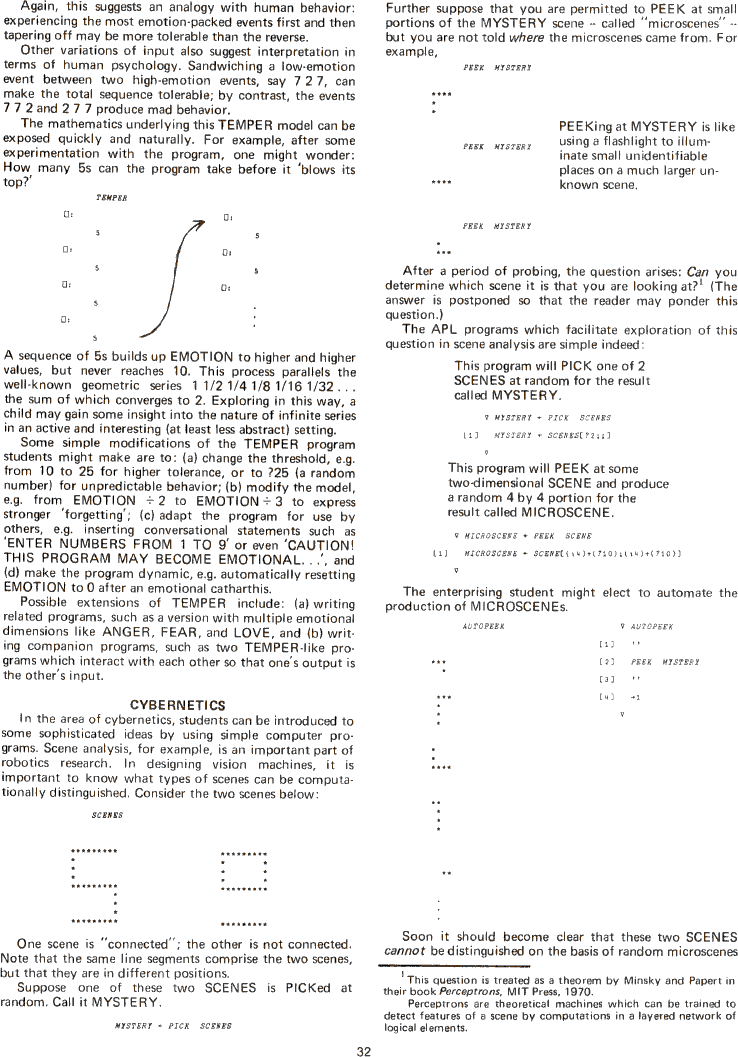The Best of Creative Computing Volume 2 (published 1977)
The Computer "Glass Box" - Teaching with A Programming Language (cybernetics)

Again, this suggests an analogy with human behavior: experiencing the most
emotion-packed events first and then tapering off may be more tolerable than the
reverse.
Other variations of input also suggest interpretation in terms of human
psychology. Sandwiching a low-emotion
event between two high-emotion events, say 7 2 7, can make the total sequence
tolerable; by contrast, the events 7 7 2 and 2 7 7 produce mad behavior.
The mathematics underlying this TEMPER model can be exposed quickly and
naturally. For example, after some
experimentation with the program, one might wonder: How many 5s can the program
take before it 'blows its
top?'
[image]
A sequence of 5s builds up EMOTION to higher and higher values, but never
reaches 10. This process parallels the well-known geometric series 1 1/2 1/4 1/8
1/16 1/32... the sum of which converges to 2. Exploring in this way, a child may
gain some insight into the nature of infinite series in an active and
interesting (at least less abstract) setting.
Some simple modifications of the TEMPER program students might make are to: (a)
change the threshold, e.g.
from 10 to 25 for higher tolerance, or to ?25 (a random number) for
unpredictable behavior; (b) modify the model, e.g. from EMOTION ÷ 2 to EMOTION
÷ 3 to express stronger 'forgetting'; (c) adapt the program for use by
others, e.g. inserting conversational statements such as 'ENTER NUMBERS FROM 1
TO 9' or even 'CAUTION! THIS PROGRAM MAY BECOME EMOTIONAL. . .', and (d) make
the program dynamic, e.g. automatically resetting EMOTION to 0 after an
emotional catharthis.
Possible extensions of TEMPER include: (a) writing related programs, such as a
version with multiple emotional
dimensions like ANGER, FEAR, and LOVE, and (b) writing companion programs, such
as two TEMPER-like programs which interact with each other so that one's output
is the other's input.
CYBERNETICS
In the area of cybernetics, students can be introduced to some sophisticated
ideas by using simple computer programs. Scene analysis, for example, is an
important part of robotics research. ln designing vision machines, it is
important to know what types of scenes can be computationally distinguished.
Consider the two scenes below:
SCENES
[image]
One scene is "connected"; the other is not connected. Note that the same line
segments comprise the two scenes, but that they are in different positions.
Suppose one of these two SCENES is PICKed at random. Call it MYSTERY.
Further suppose that you are permitted to PEEK at small portions of the MYSTERY
scene -- called "microscenes" --but you are not told where the microscenes came
from. For example,
[image]PEEK MYSTERY
PEEKing at MYSTERY is like using a flashlight to illuminate small unidentifiable
places on a much larger unknown scene.
PEEK MISTERY
PEEK MISTERY
After a period of probing, the question arises: Can you determine which scene it
is that you are looking at?' (The answer is postponed so that the reader may
ponder this question.)
The APL programs which facilitate exploration of this question in scene analysis
are simple indeed:
This program will PICK one of 2 SCENES at random for the result called MYSTERY.
MYSTERY PICK SCENES
[1] MYSTERY SCENES[?2;;]
This program will PEEK at some two-dimensional SCENE and produce a random 4 by 4
portion for the result called MICROSCENE.
MICROSCENE PEEK SCENE
[1] MICROSCENE SCENE
The enterprising student might elect to automate the production of MICROSCENEs.
[image]AUTOPEEK AUTOPEEK
[1] ''
[2] PEEK MYSTERY
[3] ''
[4] »i
Soon it should become clear that these two SCENES cannot be distinguished on the
basis of random microscenes
This question is treated as a theorem by Minsky and Papert in their book
Perceptrons, MIT Press, 1970.
Perceptrons are theoretical machines which can be trained to detect features of
a scene by computations in a layered network of logical elements.


